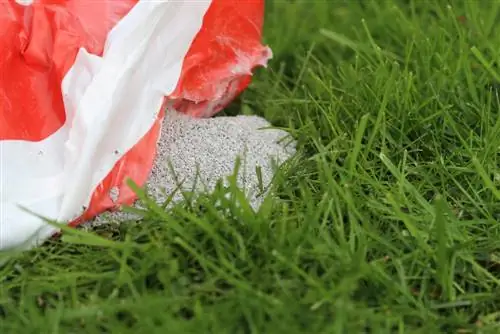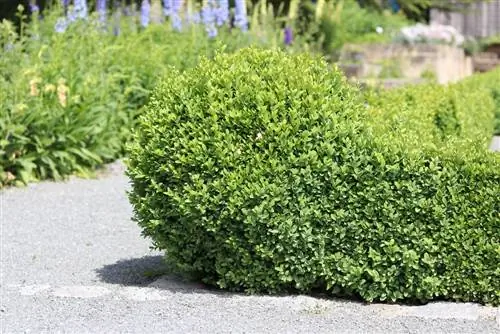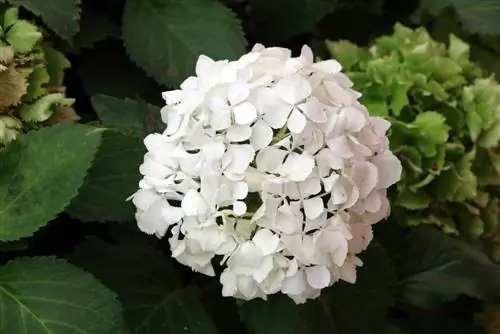- Author admin [email protected].
- Public 2023-12-17 03:39.
- Last modified 2025-01-24 12:45.
Many hobby gardeners plant their gardens with magnificent perennials, which sprout every spring. This process requires enormous effort for the plants, for which they need additional nutrients. The majority of perennials are satisfied with annual fertilization, but under certain conditions it is advisable to provide the plants with additional nutrients.
Annual basic fertilization
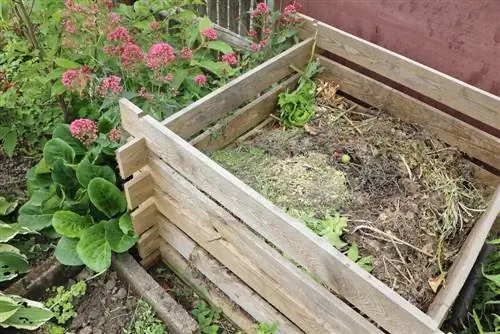
The annual basic fertilization usually takes place in spring, usually at the beginning of March. The optimal time is after the plants have been cut back and the bed has been weeded. Organic fertilizers are particularly recommended for fertilizing perennials, as they work over a long period of time and stimulate the release of nutrients from the soil. The following fertilizers are therefore recommended for annual basic fertilization:
- Compost
- Horn shavings
- Blood Meal
- Bone meal
- animal manure
The use of mineral fertilizers for annual basic fertilization is less recommended, as these cause the plants to grow too quickly. The rapid growth could cause the perennials to become unstable and even break. In addition, the plants' water requirements increase enormously, which is why they have to be watered much more frequently.
Instructions for annual basic fertilization
Before the plants sprout again in early spring is the ideal time for basic fertilization. In addition to the right fertilizer, all you need is a cultivator or a digging fork. Before fertilizing the plants, any weeds must be completely removed. The best way to remove weeds is through careful weeding. However, you should avoid using any equipment because the shallow roots could be damaged. The basic fertilization is then carried out as follows:
- Loose the soil superficially
- A cultivator or a digging fork is suitable for this
- under no circumstances loosen the soil deeply
- because many perennials have shallow roots
- then incorporate the slow-release fertilizer
- Please follow the package instructions!
- As a rule, the fertilizer is distributed among the perennials
- and lightly raked into the soil
- Finally, water the soil well
Mulching
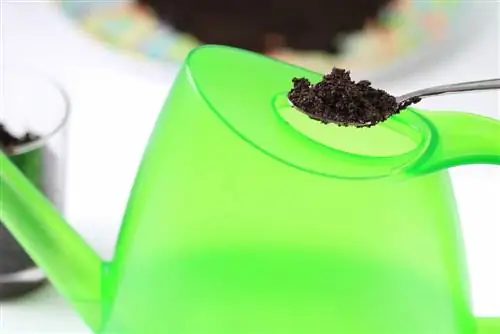
Mulching rounds off the annual basic fertilization, because all perennials and trees generally benefit from a proper layer of mulch. Mulching offers numerous advantages for the plants: the soil stays moist for longer and the growth of new weeds is partially prevented. The mulch layer also protects the soil surface from excessive heating in particularly sunny periods and at the same time prevents it from becoming muddy and washed away. Mulch also provides an optimal breeding ground for numerous soil creatures, such as earthworms, which also have a positive effect on the plants. The following materials are suitable as mulching material:
- Compost
- Lawn cutting
- Leaves
- Green waste
- Coffee grounds
- Gravel or grit
Tip:
It is advisable to avoid using bark mulch, especially when planting new plants. This has a slightly herbicidal effect, which can damage or, in the worst case, even kill the perennials.
Fertilizing in autumn
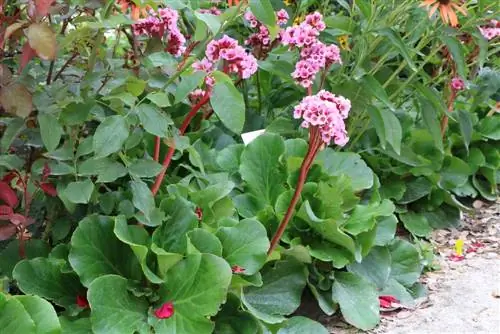
Additional fertilization in autumn is particularly recommended for evergreen and wintergreen perennials. In order to optimally prepare them for the cold winter months, they should be fertilized with a special potassium-rich fertilizer in August or September. This stimulates the metabolism of the perennials, which means they can tolerate the coming frost better. In addition, the leaves do not turn brown so quickly in the cold season and decorate the garden with their green foliage even in winter. The following perennials, among others, benefit from additional fertilization in autumn:
- Bergenia (Bergenia)
- Candytuft (Iberis)
- Houseleek (Sempervivum)
Heavy eaters
Although most perennials do not have high nutrient requirements, there are still some exceptions. There are also so-called heavy feeders among perennials, which require a higher supply of nutrients for their growth compared to their counterparts. These usually include highly cultivated perennials and flowering bedding perennials. These originally come from the North American prairies and are therefore used to nutrient-rich loess soils. However, the list of heavy feeders among perennials is relatively clear:
- Delphinium (Delphinium)
- Phloxes
- Coneflower (Echinacea)
- Sun Bride (Helenium)
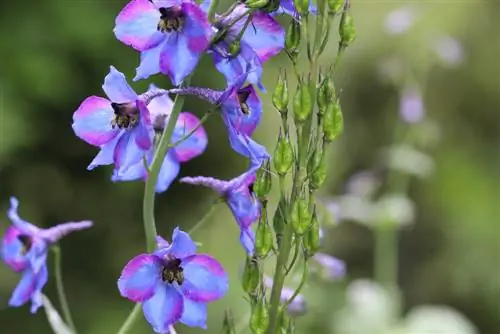
The heavy-feeding perennials should be fertilized again in early summer in addition to the basic fertilization in spring. Nettle manure is particularly suitable for this and is given to the perennials undiluted and in a ratio of 1:10. In addition, the home remedy is relatively easy to make:
- Fill 10 liter bucket with cut nettles
- Pour water up to the edge of the bucket
- ideally, rainwater is used for this
- Put the bucket in a sunny place
- stir once a day
- let ferment for about 1 to 2 weeks
- when no more bubbles appear, the manure is ready
Shade perennials
Shade perennials generally do not have high nutrient requirements. However, these also benefit from a continuous supply of nutrients. Leaf humus, which is added in spring, is particularly suitable for this. Although this is not very nutrient-rich, it acts like a fertilizer for the shade perennials and at the same time stimulates root formation. In order to supply the shade perennials with nutrients, the following approach has proven successful:
- about 3 liters of decomposed autumn leaves per square meter of bed area
- distribute the autumn leaves between the plants
Fertilize after pruning
Some types of perennials, such as steppe sage and delphinium, bloom a second time until late summer. These perennials are usually cut back to a few centimeters above the ground after the main flowering period. The remontant plants require an enormous amount of energy to bloom again, which is why additional fertilization makes sense. A mineral fertilizer, such as blue grain, is particularly suitable for this. Not only does it contain all the important nutrients, but it can also be absorbed immediately by the perennials. When administering the fertilizer, please note the following:
- Dose fertilizer sparingly
- about 1 heaped teaspoon per perennial is sufficient
- then water the plant well
- this causes the fertilizer to dissolve
- and the plant can absorb the nutrients more quickly
Improve sandy soil
Whether fertilizing makes sense also depends on the type and condition of the soil. Many German gardens often have light, sandy soils. Due to their nature, these wash out the nutrients quickly and therefore store them poorly. It is therefore worth enriching the sandy soil with compost and horn shavings. This significantly improves the soil quality because the compost adds nutrients to the soil and stimulates soil animals and microorganisms. It also improves the soil’s water and nutrient storage. When improving soil with compost, it is important to note the following:
- sprinkle the soil with compost every spring
- about 2-3 liters of mature compost per square meter
- ideally horn shavings are mixed in
- a handful of horn shavings is enough
New perennial bed

Anyone who creates a new perennial bed is often faced with the problem that unpleasant weeds quickly settle on the bare soil. This can be kept under control by regular weeding, but this requires a lot of maintenance in the first few years. As a rule, weed growth only slows down when the perennials cover the bare soil. In order to quickly form a closed plant cover, it is advisable to enrich the freshly created perennial bed with humus or compost. This also has the advantage that less fertilizer will have to be used in the coming years. To optimally prepare the new perennial bed, it is best to proceed as follows:
- Use humus, horn meal or compost
- Pour a planting shovel of ripe compost into the planting hole
- up to 40 liters per square meter
- in the top 10 cm of the soil
- Alternatively, an organic perennial fertilizer is also suitable
Tip:
Many retailers now also offer special soil for perennials. This has the advantage that it already contains all the important nutrients and therefore it is not necessary to improve the soil with compost or humus.



